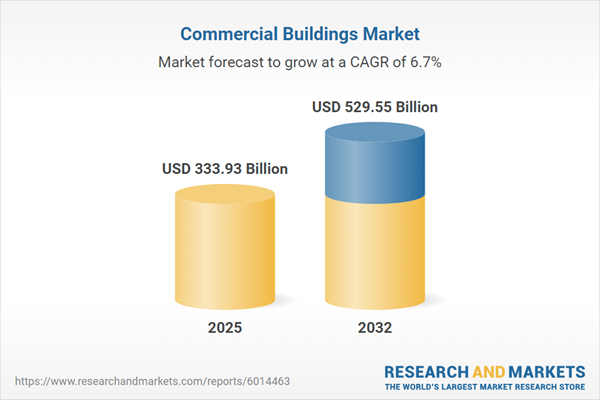Speak directly to the analyst to clarify any post sales queries you may have.
The commercial buildings market is undergoing significant transformation as industry priorities shift toward digitalization, sustainability, and evolving user expectations. Senior leaders are challenged to balance growth with resilience in a fast-changing built environment.
Market Snapshot: Commercial Buildings Market Growth and Outlook
The commercial buildings market grew from USD 314.11 billion in 2024 to USD 333.93 billion in 2025. This trajectory is expected to continue, supported by a compound annual growth rate of 6.74%, with the market projected to reach USD 529.55 billion by 2032. Escalating investments in energy-efficient solutions, digital infrastructure, and regulatory-driven upgrades are central to the market's expansion and complexity.
Scope & Segmentation
This report systematically analyzes the commercial buildings sector, delivering insights across asset types, construction approaches, technology adoption, and ownership models in all vital regions.
- Commercial Building Types: Healthcare facilities (clinic, hospital), hospitality buildings (hotels, restaurants), industrial facilities (flex, manufacturing, warehouses), mixed-use buildings, office buildings (Class A, B, C), and retail spaces (shopping center, standalone store).
- Construction Type: New construction and renovation projects.
- Building System Type: Building automation systems, elevators and escalators, fire safety and security systems, HVAC solutions (district cooling, rooftop units, split systems, variable refrigerant flow), lighting systems, and plumbing and water systems.
- Building Size: Large, medium, and small assets.
- Ownership Type: Corporate owned, franchisee owned, institutional and government-owned, and small business owned.
- Geographic Coverage: Americas (North America: United States, Canada, Mexico; Latin America: Brazil, Argentina, Chile, Colombia, Peru), Europe, Middle East & Africa (Europe: United Kingdom, Germany, France, Russia, Italy, Spain, Netherlands, Sweden, Poland, Switzerland; Middle East: United Arab Emirates, Saudi Arabia, Qatar, Turkey, Israel; Africa: South Africa, Nigeria, Egypt, Kenya), Asia-Pacific (China, India, Japan, Australia, South Korea, Indonesia, Thailand, Malaysia, Singapore, Taiwan).
- Company Coverage: Industry leaders and innovators, including ACS, Actividades de Construcción y Servicios, S.A., Brookfield Properties Corporation, Bechtel Corporation, Bouygues SA, Carrier Global Corporation, CBRE Group, Inc., Daikin Industries, Ltd., Dubai Holding LLC, Emaar Properties PJSC, Gilbane Building Company, Johnson Controls International plc, Larsen & Toubro Limited, Lennox International Inc., Mitsubishi Estate Co., Ltd., Obayashi Corporation, Power Construction Corporation of China, Prologis, Inc., Simon Property Group, Inc., Skanska AB, Strabag SE, Trane Technologies Company, LLC, Turner Construction Company, Unibail‑Rodamco‑Westfield SE, Vinci SA, Kiewit Corporation, Schneider Electric SE, and Siemens AG.
Key Takeaways: Strategic Insights for Decision-Makers
- Integrating building automation, predictive analytics, and digital management platforms optimizes operational efficiency and life-cycle performance.
- Sustainability imperatives, including decarbonization and circular economy adoption, are reshaping material sourcing, construction processes, and investment strategies across asset classes.
- Flexible workspace design and occupant-centric features, such as enhanced health and wellness systems, are influencing asset value and tenant satisfaction across offices, hospitality, and healthcare segments.
- Collaboration between technology firms, engineering consultants, and service providers is driving the delivery of turnkey smart building solutions and accelerating innovation cycles.
- Ownership structures and regional dynamics strongly affect procurement strategies, regulatory compliance, and portfolio performance, requiring careful alignment with local market drivers.
Impact of US Tariff Adjustments
- US tariff changes in 2025 have increased procurement costs for critical materials such as steel and aluminum, creating a renewed emphasis on supply chain diversification and sourcing from domestic or recycled alternatives.
- Project stakeholders are adopting modular and prefabricated construction to buffer inventory risk, support phased procurement, and streamline budgets in response to evolving trade policies.
- Advanced procurement analytics and transparent cost tracking enable organizations to forecast and mitigate price volatility, underpinning competitive resilience in uncertain policy environments.
Methodology & Data Sources
This research uses a robust combination of primary interviews with senior executives and facility managers, structured market surveys, and extensive analysis of regulatory publications, industry reports, and proprietary transaction databases. A multidisciplinary peer review validated key findings and ensured the reliability of all identified market themes.
Why This Report Matters: Actionable Value for Senior Leaders
- Guides executive strategies to align investment with emerging regulatory, digital, and sustainability imperatives across diverse property portfolios.
- Enables confident decision-making by providing actionable insights on market transformation, region-specific growth drivers, and leading technology adoption trends.
- Facilitates stakeholder alignment by translating complex market shifts into clear, prioritized opportunities and risk mitigation approaches.
Conclusion
The commercial buildings market stands at a strategic crossroad, where resilience, innovation, and operational agility drive long-term success. Forward-thinking leaders who leverage comprehensive intelligence will be best equipped to capture growth and adapt to ongoing industry shifts.
Additional Product Information:
- Purchase of this report includes 1 year online access with quarterly updates.
- This report can be updated on request. Please contact our Customer Experience team using the Ask a Question widget on our website.
Table of Contents
3. Executive Summary
4. Market Overview
7. Cumulative Impact of Artificial Intelligence 2025
Companies Mentioned
The companies profiled in this Commercial Buildings market report include:- ACS, Actividades de Construcción y Servicios, S.A.
- Brookfield Properties Corporation
- Bechtel Corporation
- Bouygues SA
- Carrier Global Corporation
- CBRE Group, Inc.
- Daikin Industries, Ltd.
- Dubai Holding LLC
- Emaar Properties PJSC
- Gilbane Building Company
- Johnson Controls International plc
- Larsen & Toubro Limited
- Lennox International Inc.
- Mitsubishi Estate Co., Ltd.
- Obayashi Corporation
- Power Construction Corporation of China
- Prologis, Inc.
- Simon Property Group, Inc.
- Skanska AB
- Strabag SE
- Trane Technologies Company, LLC
- Turner Construction Company
- Unibail‑Rodamco‑Westfield SE
- Vinci SA
- Kiewit Corporation
- Schneider Electric SE
- Siemens AG
Table Information
| Report Attribute | Details |
|---|---|
| No. of Pages | 183 |
| Published | November 2025 |
| Forecast Period | 2025 - 2032 |
| Estimated Market Value ( USD | $ 333.93 Billion |
| Forecasted Market Value ( USD | $ 529.55 Billion |
| Compound Annual Growth Rate | 6.7% |
| Regions Covered | Global |
| No. of Companies Mentioned | 28 |









